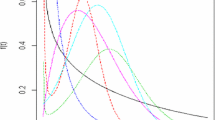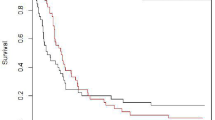Abstract
In this paper, we present various diagnostic methods for polyhazard models. Polyhazard models are a flexible family for fitting lifetime data. Their main advantage over the single hazard models, such as the Weibull and the log-logistic models, is to include a large amount of nonmonotone hazard shapes, as bathtub and multimodal curves. Some influence methods, such as the local influence and total local influence of an individual are derived, analyzed and discussed. A discussion of the computation of the likelihood displacement as well as the normal curvature in the local influence method are presented. Finally, an example with real data is given for illustration.
Similar content being viewed by others
References
Aarset MV (1987) How to identify a bathtub hazard rate. IEEE Trans Reliab 36:106–108
Barlow WE, Prentice RL (1988) Residual for relative risk regression. Biometrika 75:65–74
Basu S, Basu AP, Mukhopadhyay C (1999) Bayesian analysis for masked system failure data using non-identical Weibull Models. J Stat Plan Inference 78:255–275
Bennet S (1983) Log-logistic regression models for survival data. Appl Stat 32:165–171
Berger JO, Sun D (1993) Bayesian analysis for the poly-Weibull distribution. J Am Stat Assoc 88:1412–1418
Cook RD (1986) Assesment of local influence (with discussion). J R Stat Soc 48(2):133–169
Cook RD, Peña D, Weisberg S (1988) The likelihood displacement: a unifying principle for influence. Commun Stat Theory Methods 17:623–640
David HA, Moeschberger M (1978) The theory of competing risks. MacMillan, New York
Davison AC, Louzada-Neto F (2000) Inference for the poly-Weibull model. Statistician 49:189–196
Díaz-García JA, Galea M, Leiva-Sánchez V (2004) Influence diagnostics for elliptical multivariate linear regression models. Commun Stat Theory Methods 32:625–641
Doornik J (1996) Ox: an object-oriented matrix programming language. International Thomson Business Press.
Escobar LA, Meeker WQ (1992) Assessing influence in regression analysis with censored data. Biometrics 48:507–528
Fahrmeir L, Tutz G (1994) Multivariate statistical modelling based on generalized linear models. Springer, New York
Galea M, Riquelme M, Paula GA (2002) Diagnostics methods in elliptical linear regression models. Braz J Probab Stat 14:167–184
Klein JP, Moeschberger ML (1997) Survival analysis: techniques forcensored and truncated data. Springer, New York
Kuo L, Yang TY (2000) Bayesian reliability modeling for masked system lifetime. Stat Probab Lett 47:229–241
Lee SY, Lu B, Song XY (2006) Assessing local influence for nonlinear structural equation models with ignorable missing data. Comput Stat Data Anal 50:1356–1377
Lesaffre E, Verbeke G (1998) Local influence in linear mixed models. Biometrics 54:570–582
Louzada-Neto F (1999) Polyhazard models for lifetime data. Biometrics 55:1281–1285
McCullagh P, Nelder JA (1989) Generalized Linear Models, 2nd edn. Chapman and Hall, London
Meeter CA, Meeker WQ (1994) Optimum accelerated life tests with a nonconstant scale parameter. Technometrics 36:71–83
Mudholkar GS, Srivastava Dk, Kollia GD (1996) A generalization of the Weibull distribution with application to the analysis of survival data. J Am Stat Assoc 91:1575–1583
O‘Hara Hines RJ, Lawless JF, Carter EM (1992) Diagnostics for a cumulative multinomial generalized linear model with application to grouped toxicological mortality data. J Am Stat Assoc 87:1059–1069
Ortega EMM (2001) Influence analysis and residual in generalized log-gamma regression models. Doctor Thesis, Department of Statistics, University of São Paulo, Brasil (in Portuguese)
Ortega EMM, Bolfarine H, Paula GA (2003) Influence diagnostics in generalized log-gamma regression models. Comput Stat Data Anal 42:165–186
Ortega EMM, Cancho VG, Bolfarine H (2006) Influence diagnostics in exponentiated-Weibull regression models with censored data. Stat Oper Res Trans 30:171–196
Paula GA (1993) Assessing local influence in restricted regressions models. Comput Stat Data Anal 16:63–79
Paula GA (1995) Influence residuals in restricted generalized linear models. J Stat Comput Simul 51:63–79
Pettit AN, Bin Daud I (1989) Case-weight measures of influence for proportional hazards regression. Appl Stat 38:51–67
Shyur H, Elsayed AE, LuxhHj JT (1999) A general model for accelerated life testing with time-dependent covariates. Naval Res Logist 46:303–321
Therneau TM, Grambsch PM, Fleming TR (1990) Martingale-based residuals for survival models. Biometrika 77:147–60
Thomas W, Cook RD (1990) Assessing influence on predictions from generalizes linear models. Technometrics 32:59–65
Williams DA (1984) Residuals in generalized linear model diagnostic using the deviance and single case deletion. Appl Stat 36:181–191
Author information
Authors and Affiliations
Corresponding author
Rights and permissions
About this article
Cite this article
Fachini, J.B., Ortega, E.M.M. & Louzada-Neto, F. Influence diagnostics for polyhazard models in the presence of covariates. Stat Meth Appl 17, 413–433 (2008). https://doi.org/10.1007/s10260-007-0067-3
Accepted:
Published:
Issue Date:
DOI: https://doi.org/10.1007/s10260-007-0067-3




